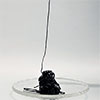| Feb 18, 2022 |
|
(Nanowerk News) Conventional ink formulations for printing two-dimensional (2D) materials commonly use additives such as surfactants, binders, and rheology modifiers to prevent the inks from becoming thermodynamically unstable. For instance, large concentrations of polymeric binders are needed to increase the viscosity of graphene inks to a level that is suitable for screen printing.
|
|
Unfortunately, additives tend to adversely affect the electronic properties, such as conductivity, of the printable inks and also reduce their active surface area. That’s why there usually is an additional step at the end of the fabrication process to remove the additives. This, however, requires high-temperature thermal treatments (typically at 300–400 °C), which often cannot fully recover the electronic properties (especially for semiconducting materials), limit the choice of materials, complicate the fabrication process, can lead to drastic chemical degradation and loss of functionality, and increase the manufacturing costs.
|
|
To address these problems, researchers have reported in Advanced Materials (“A Universal Approach for Room-Temperature Printing and Coating of 2D Materials”) a new class of additive-free inks that exploit the unique ability of 2D nanosheets to form percolating networks, accommodating a given solvent.
|
|
In these inks, the roles of the traditional additives such as stabilizing the dispersion, adjusting the ink’s rheological properties, and binding the particles to each other (cohesion) and the film to the substrate (adhesion), are fully taken over by interparticle van der Waals (vdW) attractions, enabling completely room-temperature processing of 2D materials.
|
 |
| Figure 1. Structure and film-formation of aggregated 2D materials. a) Left: An aggregated graphene dispersion in NMP (1 vol%), capable of forming a gel (φ > φgel); Right: A transparent film obtained from the same dispersion after homogenization (low-shear treatment). Scale bars: 1 cm. b) Low-shear treatment of an aggregated dispersion in a dynamic shear rheometer by low-speed rotation of parallel plates. Curve (I): as-obtained aggregated dispersion. The huge irrecoverable drop in the viscosity during the ramp-up stage suggests a structural ordering. Curves (II) and (III): the repetitions of the same test on the same ink with 30 min rest in between. Curve (IV): the same ink after a three-roll-mill treatment. c) Amplitude sweep test of vdW inks made of different 2D materials with different solid contents, confirming their gel structure. d) Schematic illustration of the internal structure of (left) an aggregated dispersion with φ > φgel and (right) the gel obtained after shear-treating the aggregated dispersion. e) Binary X-ray tomogram (scale bar: 40 µm) and f) SEM image (scale bar: 2 µm) of a freeze-dried graphene vdW ink. (Reprinted with permission from Wiley-VCH Verlag) (click on image to enlarge)
|
|
As the authors explain, to realize these vdW inks, the 2D nanosheets must be brought close enough to each other to establish the vdW interactions (aggregation) and form a space-filled gel.
|
|
While the particles’ volume fraction is the only requirement for the formation of these gels, the initial aggregated dispersion (Figure 1a left) is an inhomogeneous mixture of two phases with unstable rheological properties (Figure 1b) that can neither be printed nor coated.
|
|
To process such a dispersion into a printable or coatable ink with a steady flow behavior (Figure 1b,c), and capable of forming a continuous film (Figure 1a right), it is necessary to carry out a short and gentle shear-treatment (e.g., by three-roll-milling).
|
|
This shear treatment leads to a substantial and irrecoverable drop in the viscosity of the aggregated system (Figure 1b), indicating the flattening and aligning of the crumpled or folded nanosheets (Figure 1d). This results in the formation of a gel (Figure 1c): a homogeneous dispersion of a liquid (solvent) within a solid phase (3D network of nanosheets). The flow behavior of the inks and mechanical properties of the resultant films are mainly controlled by the interflake vdW attractions.
|
|
The ability of aggregated dispersions to form a film depends on their solid content. Upon drying the ink after deposition, the percolated 3D network which incorporates the solvent (Figure 1e,f) collapses, and eventually, a uniform and continuous film is obtained.
|
|
In their paper, the researchers discuss in detail the structure of the vdW inks, their rheological properties, and film-formation behavior. They also demonstrate large-scale production and formulation of the vdW inks for major high-throughput printing and coating methods, as well as their application for room-temperature fabrication of functional films/devices.
|


